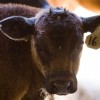 Cull vegetables can be an economical source of nutrients in beef cattle diets. They may be offered to beef cattle producers at a decreased cost or no cost. This 3-page fact sheet discusses the nutrient content and characteristics that need to be understood when utilizing cull vegetables. Written by Courtney Davis, Lindsey Wiggins, and Matt Hersom, and published by the UF Department of Animal Sciences, August 2012.
Cull vegetables can be an economical source of nutrients in beef cattle diets. They may be offered to beef cattle producers at a decreased cost or no cost. This 3-page fact sheet discusses the nutrient content and characteristics that need to be understood when utilizing cull vegetables. Written by Courtney Davis, Lindsey Wiggins, and Matt Hersom, and published by the UF Department of Animal Sciences, August 2012.
http://edis.ifas.ufl.edu/an280
Tag: Beef Cattle Feed
Environmental and Economic Benefits of Selecting Beef Cattle for Feed Efficiency (AN276/AN276)
Selecting for feed efficiency based on residual food intake can significantly impact the amount of nutrients consumed and excreted per cow without compromising animal performance. Fresh manure output and excretions of phosphorous and nitrogen could be reduced by 29%, while methane emissions can be reduced by as much as 28% when selecting more feed-efficient animals. This 4-page fact sheet was written by Nicolas DiLorenzo and G. Cliff Lamb, and published by the UF Department of Animal Science, February 2012.
http://edis.ifas.ufl.edu/an276
Preconditioning Calves Using Co-products (AN260)
Preconditioning cattle is a way to add value to a calf crop. It involves weaning, vaccination, and acclimating cattle to eating from feed bunks. This publication will focus on the nutrition, feedstuff considerations, and performance potential for different co-product options in preconditioning management. This 8-page fact sheet was written by Matt Hersom, Todd Thrift, and Joel Yelich , and published by the UF Department of Animal Science, May 2011.
http://edis.ifas.ufl.edu/an260
AN244 Winter Feed Estimator: A Practical Tool for the Beef Cow-Calf Producer
AN244, a 3-page fact sheet by Mark Warren, Ed Jennings, and Matt Hersom, provides a simple approach for estimating dry matter feed requirements of the beef herd and then converting those requirements into an estimate of required hay or silage round rolls. Published by the UF Department of Animal Science, June 2010.
http://edis.ifas.ufl.edu/an244
AN241 Wet Brewers Grains for Beef Cattle
AN241, a 4-page fact sheet by Megan Thomas, Matt Hersom, Todd Thrift, and Joel Yelich, describes this by-product of the beer-brewing industry — feed characterstics, considerations for use, and feeding guidelines. Includes references. Published by the UF Department of Animal Sciences, May 2010.
http://edis.ifas.ufl.edu/an241
AN225 Distiller Grains for Beef Cattle Feeding
AN225, a 3-page fact sheet by Bob Myer and Travis Maddock, describes these co-products of ethanol production which are commonly sold as livestock feed — its nutrient composition and issues with using it as feed. Published by the UF Department of Animal Sciences, September 2009.
http://edis.ifas.ufl.edu/AN225
AN212 Cull Whole Peanuts as a Feed Supplement for Beef Cows
AN212, a 3-page illustrated fact sheet by Bob Myer and Gary Hill, presents the results of a two-year study conducted at NFREC in Marianna, Florida to evaluate raw whole cull peanuts as a potential protein and energy supplement feed for beef cows. Published by the UF Department of Animal Science, January 2009.
http://edis.ifas.ufl.edu/AN212
AN201/AN201 Corn Gluten Feed for Beef Cattle
AN-201, a 4-page fact sheet by Bob Myer and Matt Hersom, provides beef cattle producers with basic information about this co-product of wet-corn milling industry that is readily available in the southeastern USA — utilization, considerations for use, and feeding guidelines. Includes references and a table of typical nutrient composition of corn gluten feed (CGF). Published by the UF Department of Animal Science, April 2008.
http://edis.ifas.ufl.edu/AN201